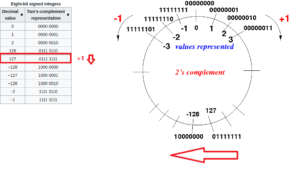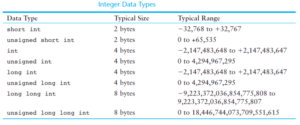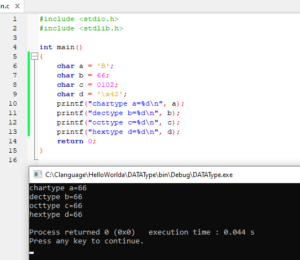Integer data types represent whole numbers without a fractional component, while floating-point data types represent real numbers with a fractional component.
Integer data types are typically used for counting and indexing, as well as for representing data that naturally consists of whole numbers, such as the number of items in a collection. They are usually stored as binary numbers and have a fixed size, which limits the range of values they can represent. For example, an 8-bit integer can represent values from 0 to 255, while a 32-bit integer can represent values from -2,147,483,648 to 2,147,483,647.
Floating-point data types are used for representing real numbers that may have a fractional component, such as measurements, physical quantities, or the result of mathematical calculations. They are usually stored in scientific notation with a sign bit, a mantissa, and an exponent, and have a variable precision that determines the number of significant digits they can represent.
The precision of floating-point data types depends on the number of bits used to represent the mantissa and the exponent, with larger types providing more precision. For example, a single-precision floating-point number (float) has a precision of about 7 decimal digits, while a double-precision floating-point number (double) has a precision of about 16 decimal digits.
Differences between Integer Data Type and Floating-Point Data Type:
- Integers do not have a fractional part, while floating-point numbers do.
- Negative integers are represented using two’s complement, while the exponent part of a floating-point type is represented using an offset.
- The range that floating-point numbers can represent is larger than that of integers.
- For some arithmetic operations (such as subtracting two very large numbers), floating-point numbers lose more precision than integers.
- Since there are infinitely many real numbers in any interval, computer floating-point numbers cannot represent all values in the interval. Floating-point numbers are usually only approximations of actual values. (For example, 7.0 may be stored as the floating-point value 6.99999.)
- In the past, floating-point operations were slower than integer operations. However, many CPUs now include floating-point processors, which have reduced the speed gap.
Here’s a table that summarizes the main differences between integer and floating-point data types
| Integer Data Type | Floating-Point Data Type | |
|---|---|---|
| Definition | Represents whole numbers | Represents real numbers with fractional parts |
| Storage | Takes up a fixed amount of memory depending on its type (e.g., short int = 2 bytes, long int = 4 bytes) |
Takes up a variable amount of memory depending on its type (e.g., float = 4 bytes, double = 8 bytes) |
| Range | Limited to a certain range of values depending on its type (e.g., short int = -32,768 to 32,767, unsigned long int = 0 to 4,294,967,295) |
Can represent a much wider range of values than integers |
| Precision | Always precise (i.e., no rounding errors) | Subject to rounding errors due to finite precision |
| Arithmetic | Can perform arithmetic operations (addition, subtraction, multiplication, division) using integer arithmetic | Can perform arithmetic operations using floating-point arithmetic |
| Usage | Typically used for counting or indexing | Typically used for scientific computations, financial calculations, or other applications where decimal accuracy is required |
Overall, the main difference between integer and floating-point data types is that integers represent whole numbers and take up a fixed amount of memory, while floating-point numbers represent real numbers with fractional parts and take up a variable amount of memory.
Integers have a limited range of values and are always precise, while floating-point numbers can represent a much wider range of values but are subject to rounding errors.






